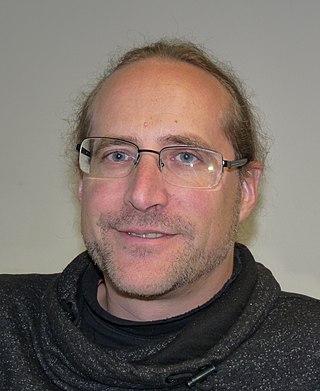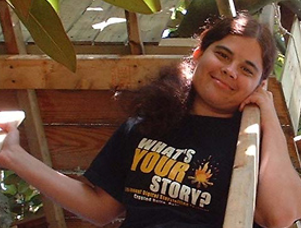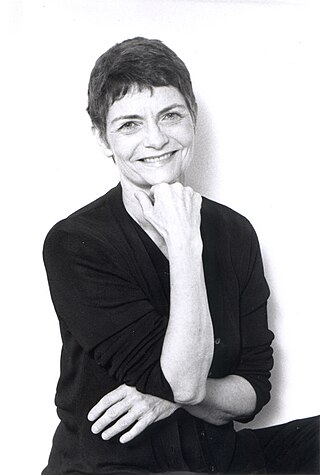
Jaka Železnikar is a Slovenian artist known for his computational poetry and internet art. The base of his work is a nonlinear language-based expression combined with visual art. Since 1997 he has been part of the net art community, and since 2004 he has created several expressive add-ons for the Firefox browser.
Electronic literature or digital literature is a genre of literature where digital capabilities such as interactivity, multimodality or algorithmic text generation are used aesthetically. Works of electronic literature are usually intended to be read on digital devices, such as computers, tablets, and mobile phones. They cannot be easily printed, or cannot be printed at all, because elements crucial to the work cannot be carried over onto a printed version.

Cybertext as defined by Espen Aarseth in 1997 is a type of ergodic literature where the user traverses the text by doing nontrivial work.

Caterina Davinio is an Italian poet, novelist and new media artist. She is the author of works of digital art, net.art, video art and was the creator of Italian Net-poetry in 1998.
Net-poetry is a development of net.art, involving poetry. This kind of experimental art was born in several different cities and countries around 1995.
Video poetry is poetry in video form. It is also known as videopoetry, video-visual poetry, poetronica, poetry video, media poetry, or Cin(E)-Poetry depending on the length and content of the video work and the techniques employed in its creation.

Philadelpho Menezes. Brazilian poet, visual poet, pioneer of new media poetry, professor in the Communication and Semiotics post-graduation program at the Pontifical University of São Paulo. He performed research for his post-graduate degree at the University of Bologna, in Italy (1990). With Brazilian artist Wilton Azevedo Philadepho Menezes created a pioneer intermedia-poetry CD-ROM: "InterPoesia. Poesia Hipermidia Interativa" (1998). In Italy he collaborated with the first net-poetry project: Karenina.it, by Italian artist Caterina Davinio.

Prehistoric Digital Poetry: An Archaeology of Forms, 1959–1995 is a nonfiction book by C. T. Funkhouser. It provides documentation and literary criticism of early forms of electronic literature and digital poetry, many of which are no longer accessible. It was published in 2007 by the University of Alabama Press, Tuscaloosa, Alabama, United States.
Eugenio Miccini was an Italian artist and writer, considered to be one of the fathers of Italian visual poetry.

Internet art is a form of new media art distributed via the Internet. This form of art circumvents the traditional dominance of the physical gallery and museum system. In many cases, the viewer is drawn into some kind of interaction with the work of art. Artists working in this manner are sometimes referred to as net artists.

Deena Larsen is an American new media and hypertext fiction author involved in the creative electronic writing community since the 1980s. Her work has been published in online journals such as the Iowa Review Web, Cauldron and Net, frAme, inFLECT, and Blue Moon Review. Since May 2007, the Deena Larsen Collection of early electronic literature has been housed at the Maryland Institute for Technology in the Humanities.
Robert Kendall is a digital poet. Canadian-born, he now lives in the United States. He has a master's degree in Musicology and has taught electronic poetry for the New School University's online course.

Stephanie Strickland is a poet living in New York City. She has published ten volumes of print poetry and co-authored twelve digital poems. Her files and papers are being collected by the David M. Rubenstein Rare Book And Manuscript Library at Duke University.
Code poetry is literature that intermixes notions of classical poetry and computer code. Unlike digital poetry, which prominently uses physical computers, code poems may or may not run through executable binaries. A code poem may be interactive or static, digital or analog. Code poems can be performed by computers or humans through spoken word and written text.
Amaranth Borsuk is an American poet and educator known for her experiments with textual materiality and digital poetry. She is currently an associate professor at the University of Washington Bothell's School of Interdisciplinary Arts & Sciences, where she teaches undergraduate courses on poetry, philology, and experimental writing. She also serves as the Chair of the school's M.F.A. program in Creative Writing, which she co-chaired from 2018 to 2022.
John Howland Cayley is a Canadian pioneer of writing in digital media as well as a theorist of the practice, a poet, and a Professor of Literary Arts at Brown University.
Ladislao Pablo Győri is an Argentine engineer, digital and visual artist, essayist and poet, most known as the creator of Virtual Poetry in 1995, which has been described as "of utmost significance in advancing literature as sculptural object in electronic space". He has been described as one of the rare "poet-practitioners dedicated to 3-D art".
haikU is a browser-based, audience participatory, haiku poem project. The project displays randomly generated haiku poems, and allows the Internet audience to contribute to the project's database of haiku lines. The project is known as a work of electronic literature and for its use of an evolving database, and for the relative coherence of its output. It was created by Nanette Wylde in 2001 and is considered a form of interactive digital poetry.







